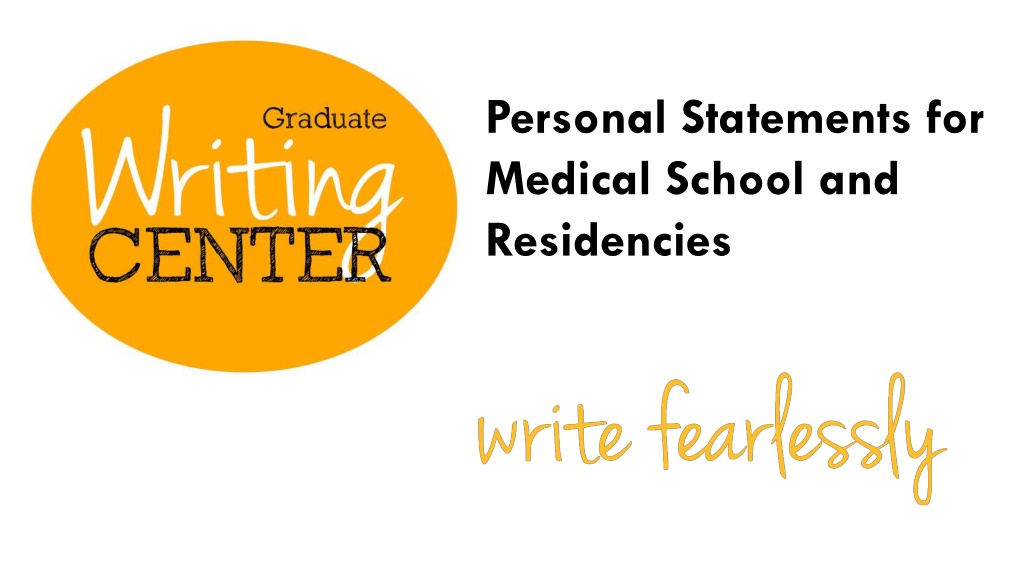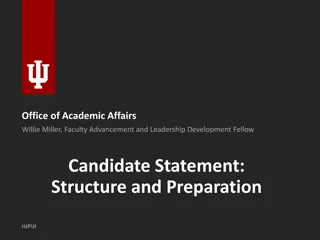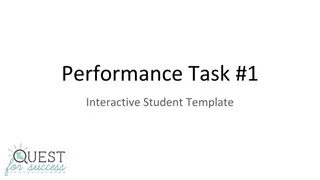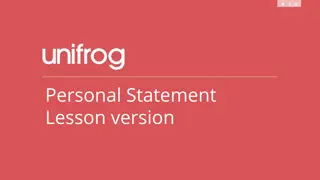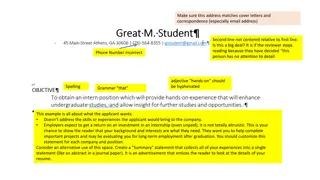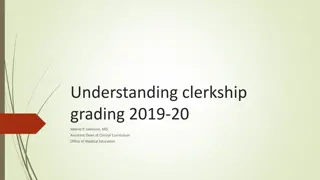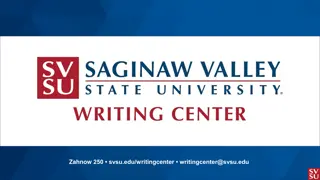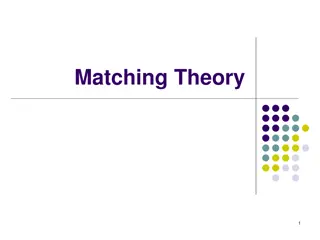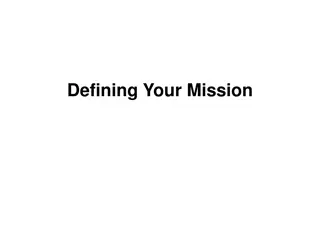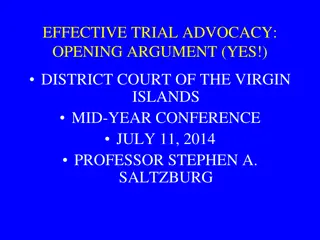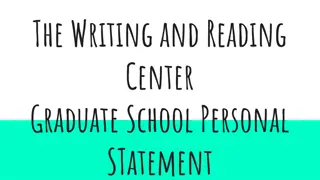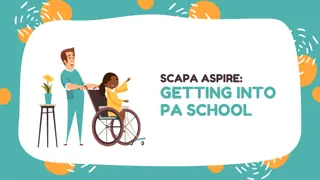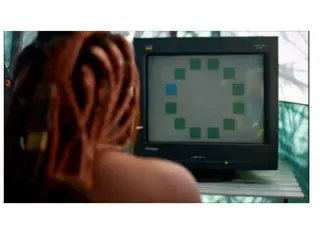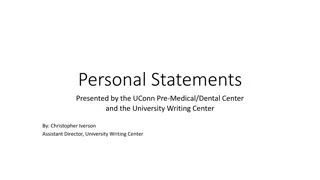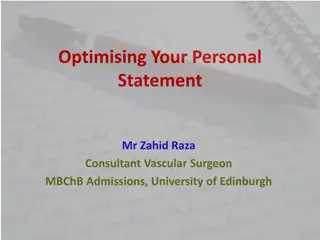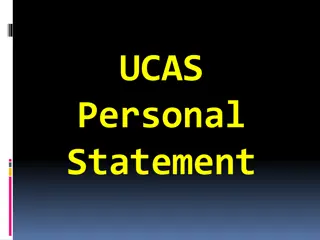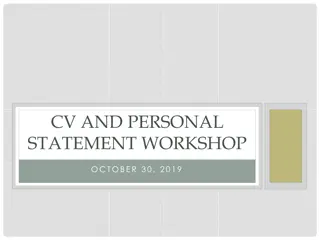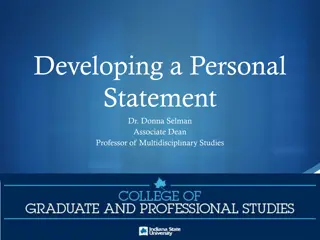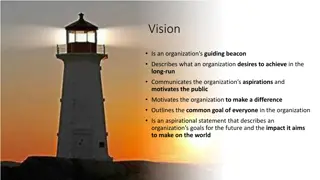Crafting a Compelling Personal Statement for Medical School and Residencies
Craft a personal statement that resonates with the admissions committee by focusing on showcasing your motivations, experiences, and qualities in an engaging and memorable way. Learn from mentor texts, employ the PEEL structure, and create a narrative that illustrates your journey towards a career in medicine effectively.
Download Presentation

Please find below an Image/Link to download the presentation.
The content on the website is provided AS IS for your information and personal use only. It may not be sold, licensed, or shared on other websites without obtaining consent from the author. Download presentation by click this link. If you encounter any issues during the download, it is possible that the publisher has removed the file from their server.
E N D
Presentation Transcript
Personal Statements for Medical School and Residencies
Your Audience and What They Need Your personal statement will be read by an admissions committee that likely includes faculty, staff, and perhaps second-year students, doctors, or other medical professionals. Not all committee members will be medical or scientific insiders, so an audience-friendly personal statement should be free of jargon and unexplained technical language. Although committee members will have reviewed your test scores, coursework and GPA, and resume, they will rely on your personal statement to understand who you are, what motivates you to enter medicine, how your qualities and experiences have prepared you for this challenge all through the focused and detail-rich story you tell that makes you and your application engaging and memorable. While a personal statement aims to inform readers (about your studies, experiences, and achievements), it should communicate how what you did in the past (retrospective) prepares and motivates you for a future in medicine (prospective). While a personal statement aims to persuade readers (that they want to invite you to interview), it persuades through showing more than telling or asserting.
Start with Lessons from Mentor Texts When you read a mentor text a successful example of a kind of writing you want to do you do so to draw lessons, devise strategies, and spark ideas for your writing. Browse 10 Successful Medical School Essays at https://www.thecrimson.com/topic/sponsored-successful-medical-essays-2019/ Choose those that stand out for you to read carefully, taking notes on how the writer creates a hook in the first paragraph(s) to immerse readers in an experience or perspective develops that hook from paragraph to paragraph, creating cohesion and also momentum, progression, possibly surprise illustrates the developing story or theme with experiences and skills that may be listed in the resume or other parts of the application but also provides a perspective or insight that a resume does not (including soft skills like empathy, persistence, or humility) Enables readers to answer the questions, Who is this applicant? What has motivated them to enter a medical profession? What preparation and qualities do they bring?
More Lessons from Mentor Texts As you continue learning from your mentor texts and developing your person statement, consider how each paragraph fulfills the elements of PEEL: P = Point, a paragraph s first sentence or two, establishing that paragraph s focus E = Evidence to illustrate the paragraph s focus E = Explanation, direct or implied, of how this paragraph s point and evidence contribute to your motivation and preparation for becoming a health professional L = Link, the final sentence(s) in a paragraph that begin the turn toward the next paragraph
PEEL in Action From Jordan s personal statement https://www.thecrimson.com/topic/sponsored-successful-medical-essays-2019/ Point: I arrived one morning as usual, but Dr. Q pulled me aside before rounds. She said one of the patients we had been seeing passed away in the night. Evidence: I held my composure in the moment, but I felt as though an anvil was crushing down on me. It was tragic but I knew loss was part of the job, so I told myself to push forward. A few days later, I had mostly come to terms with what happened, but then the anvil came crashing back down with the passing of another patient. I could scarcely hold back the tears this time. Explanation: That moment, it didn t matter how many miraculous successes were happening a few doors down. Nothing overshadowed the loss, Link: and there was no way I could get used to it as my younger self had hoped.
Try These Pre-Writing Brainstorming Exercises Origins and Journeys: What and who created and contributed to your desire to enter a health profession over other helping professions such as teaching or social work? Was there a defining moment or a journey with twists and turns bringing you to this conclusion? Stories of journeys often contain obstacles and helpers. What/who were yours? Own your exceptionalism: What makes you stand out in a crowd and how will that make you a better health professional? Think about experiences, traits, and talents (including those that may seem tangential to health and medicine but have enriched who you are and who you will be as a health professional). Consider how markers of your identity economic class, nationality, race, gender expression, age, dis/ability contribute to what makes you unique and uniquely prepared to enter the health professions. Inventory your qualifications: What experiences in and beyond health care contribute to your preparedness for your career path? Include, illustrate, and reflect upon classes, research experience, direct contact with and work in medicine. Also include, illustrate, and reflect upon studies, activities, and experiences that may seem outside the health professions but enrich and inform your understanding of and commitments in medicine.
A Checklist of Dos (Adapted from Career Services at Harvard) DO: Tell a story or introduce and develop a compelling theme. Use specific examples and anecdotes. Think of the mantra Show, don t tell. Describe experiences not only in terms of what happened also what they mean to you, how they changed you, and what you learned, especially in the context of entering a medical field. When describing research experiences, emphasize what you learned and gained over the fine details of a particular research project. Rely on strong action verbs, active voice, and precise nouns to create vivid images and an engrossing story. Be concise. Make sure every sentence needs to be there. Allow plenty of time to revise, reflect, and revise again, asking of each sentence Does this absolutely need to be here? and of each paragraph, How does this contribute to and build on the story/theme I am trying to develop? Proofread by reading your draft out and asking others to read your draft. You do want to be memorable but not for overlooked typos!
A Checklist of Donts (Adapted from Career Services at Harvard) DON T: Just list or summarize your activities or try to share everything there is to know about you. (Instead, selectively choose aspects of your experiences and activities that help you develop a cohesive story or theme, communicating how and why where you have been has prepared you for this next step in a medical career.) Don t use flowery or inflated language to try to impress readers. (Instead, communicate who you are through your own conversational voice.) Directly tell the reader that you are compassionate, motivated, curious etc. (Instead, use your specific examples and developing story to show these qualities.) Be negative about others or make excuses for weak spots in your application. (Instead, use the story/theme you develop to provide context for or a positive trait developed from a challenging situation: e.g., persevering and excelling after an early poor grade.)
Further Resources and Next Steps Check out these two web resources to help you develop, revise, refine, and edit your statement: From The Student Doctor Network: https://www.studentdoctor.net/2007/06/23/before-you-write- your-personal-statement-read-this/ From the University of Minnesota: https://healthcareers.umn.edu/courses-and-events/online- workshops/personal-statements Make an appointment with the Graduate Writing Center: In person, via Teams, Email Feedback Letter, Thursday evening Graduate Writing Retreats Brainstorming and mapping Developing, organizing, big-picture revision Editing for clarity, concision, and voice Proofreading and final polish Fresh eyes, an interested outside reader s perspective
To Make an Appointment Create an account at uvm.mywconline.net Click on an available appointment, and choose in-person, online via Teams, Email Feedback Letter, or Graduate Writing Retreat Option: Attach or link a draft Option: Make a two-part Review and Meet appointment Option: Make several appointments with one consultant to draft, revise, and edit over time. Or make appointments with two or more consultants for diverse perspectives. Also visit https://www.uvm.edu/gradwriting/writing-resources for guides to Revising and Reorganizing Sentence Strategies for Flow Editing for Clarity, Cohesion, and Concision
